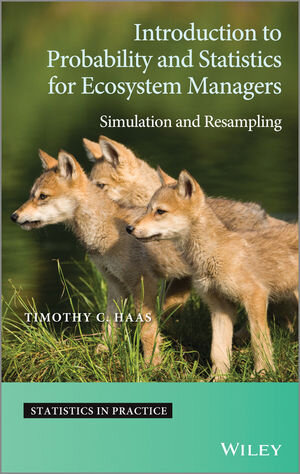
„Ultimately, the ecosystem manager who works through this volume and works through the many examples provided will emerge with a valuable toolbox of analysis techniques.“ (The Quarterly Review of Biology, 1 December 2015)
Introduction to Probability and Statistics for Ecosystem Managers
Simulation and Resampling
von Timothy C. HaasExplores computer-intensive probability and statistics forecosystem management decision making
Simulation is an accessible way to explain probability andstochastic model behavior to beginners. This book introducesprobability and statistics to future and practicing ecosystemmanagers by providing a comprehensive treatment of these two areas. The author presents a self-contained introduction for individualsinvolved in monitoring, assessing, and managing ecosystems andfeatures intuitive, simulation-based explanations of probabilisticand statistical concepts. Mathematical programming details areprovided for estimating ecosystem model parameters with MinimumDistance, a robust and computer-intensive method.
The majority of examples illustrate how probability andstatistics can be applied to ecosystem management challenges. Thereare over 50 exercises - making this book suitable for alecture course in a natural resource and/or wildlife managementdepartment, or as the main text in a program of self-study.
Key features:
* Reviews different approaches to wildlife and ecosystemmanagement and inference.
* Uses simulation as an accessible way to explain probability andstochastic model behavior to beginners.
* Covers material from basic probability through to hierarchicalBayesian models and spatial/ spatio-temporal statisticalinference.
* Provides detailed instructions for using R, along with completeR programs to recreate the output of the many examplespresented.
* Provides an introduction to Geographic Information Systems(GIS) along with examples from Quantum GIS, a free GIS softwarepackage.
* A companion website featuring all R code and data usedthroughout the book.
* Solutions to all exercises are presented along with an onlineintelligent tutoring system that supports readers who are using thebook for self-study.
Simulation is an accessible way to explain probability andstochastic model behavior to beginners. This book introducesprobability and statistics to future and practicing ecosystemmanagers by providing a comprehensive treatment of these two areas. The author presents a self-contained introduction for individualsinvolved in monitoring, assessing, and managing ecosystems andfeatures intuitive, simulation-based explanations of probabilisticand statistical concepts. Mathematical programming details areprovided for estimating ecosystem model parameters with MinimumDistance, a robust and computer-intensive method.
The majority of examples illustrate how probability andstatistics can be applied to ecosystem management challenges. Thereare over 50 exercises - making this book suitable for alecture course in a natural resource and/or wildlife managementdepartment, or as the main text in a program of self-study.
Key features:
* Reviews different approaches to wildlife and ecosystemmanagement and inference.
* Uses simulation as an accessible way to explain probability andstochastic model behavior to beginners.
* Covers material from basic probability through to hierarchicalBayesian models and spatial/ spatio-temporal statisticalinference.
* Provides detailed instructions for using R, along with completeR programs to recreate the output of the many examplespresented.
* Provides an introduction to Geographic Information Systems(GIS) along with examples from Quantum GIS, a free GIS softwarepackage.
* A companion website featuring all R code and data usedthroughout the book.
* Solutions to all exercises are presented along with an onlineintelligent tutoring system that supports readers who are using thebook for self-study.






